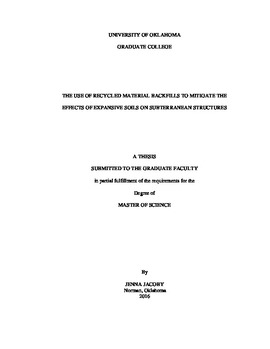| dc.description.abstract | The extreme annual weather patterns of the Midwest United States have created a demand for basements as emergency shelters in both residential and commercial structures. However, with the majority of the Midwest experiencing vast changes in the weather patterns between seasons while simultaneously being underlain by expansive soils, the associated shrink and swell generates a significant problem for basement design. As traditional backfill materials can be costly and of limited availability, this study looks at using recycled backfills to mitigate the effects of expansive soils on basements as a possible solution to both issues. This project includes a review of the current literature describing the effects of expansive soils on basements and the traditional mitigation methods used. Specifically, the review focused on the different types of backfill materials used and their effectiveness on mitigating the effects of shrink and swell.
Three recycled materials – crumb rubber, glass cullet, and shredded plastic – were evaluated for desirable characteristics prior to bench scale tests, and one material, crumb rubber, was used for bench scale tests. The crumb rubber was not treated outside of compaction efforts. The evaluated recycled backfill materials had material properties that reflected traditional backfill properties, such as particle size and consistency. Laboratory experiments were conducted to analyze the effects of shrink and swell on small scale basement walls in K0 conditions without any backfill. Various thicknesses of recycled backfill were tested to determine the optimal thickness in reducing the effects of the shrink and swell. The results of this investigation provided information on the effectiveness of recycled materials as an alternate solution to traditional backfills for subterranean structures built in expansive soils. Recycled materials will simultaneously provide an environmentally conscious option. This paper discusses the testing procedures, interpretation of the acquired data, and recommendations for the use of recycled materials as an alternate means to customary backfill materials.
Three bench scale tests were run using crumb rubber, and one additional test was run with soil only. The three tests with crumb rubber were compared to the test with soil only. It was determined that a 1:6 backfill height to total height ratio produced at maximum a 66% decrease in swell pressure at 80% soil compaction. However, at 90% soil compaction, the percent reduction decreased to 27%. It was also found that there is a strong correlation between compaction percentage and reduction in swell pressure when using the same backfill height to total height ratio, with a linear regression value of 0.9918 when comparing the three tests that used crumb rubber. Using this correlation and extrapolating the data to 95% compaction, the swell pressure would only be reduced 12% if a 1:6 backfill height to total height ratio is used. When comparing crumb rubber cost to sand fill cost, the cost of crumb rubber is approximately 1.1 to 8.7 times more expensive than sand, when normalizing for the amount needed.
Looking at the finite difference modeling, the FLAC results are somewhat comparable to the actual tests completed. The general patterns are overall correct, with the displacement occurring in the expected direction and the greatest stresses on the bottom of the box towards the center. However, some of the actual values are much greater than what was actually seen in the bench scale tests. | en_US |
